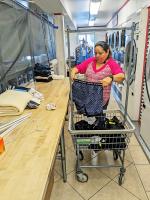AUSTIN, Texas — For the self-service laundry that also offers wash-dry-fold (WDF) service through drop-off and/or pickup and delivery, when attendants process orders at the same time self-service customers are trying to do their laundry, there’s always the risk of creating conflict, especially if both groups are vying for the same washers and dryers.
Dedicating an area (or, as you’ll read, time periods) to WDF processing will help keep a laundry’s self-service customers happy and the separate revenue streams flowing freely. Of course, laundromats can vary in service needs, store size and design, so what one business can accomplish easily may not come so simply for another.
American Coin-Op interviewed the owners of three different laundry businesses, in three different parts of the country, to see how they have approached the concept of dedicated WDF space.
WAREHOUSING CONNECTION
The Folde is a laundry pickup and delivery service that relies on laundromats it owns in Houston and Austin, Texas, as processing hubs. Mark Vlaskamp is co-owner and managing partner.
“When looking for a store, we look for size as the No. 1 criteria — knowing that we can fill them up with WDF,” Vlaskamp says. He calls his company’s two stores “monsters.”
“(We’re at) 7,500 square feet in Austin and 10,000 square feet in Houston,” Vlaskamp says. “Both have separate space for WDF and PUD while still offering self-service to our retail laundromat customers. In these stores, we have about 70 employees … broken into drivers, loaders, folders and attendants” supervised by six managers (four in Austin, two in Houston).
Warehousing is The Folde’s main reason for the separate WDF/PUD space, he explains.
“The warehouses are connected but separate from the retail laundromat,” Vlaskamp says. “These ‘Employees Only’ spaces are similar to the back of house at a restaurant. They’re warehouses to store, organize and stage either 1) clean laundry that is set to be delivered to the customer or 2) dirty laundry that is set to go into our production process.”
Each store has about 2,000 square feet of connected warehouse space.
“We process 150 to 200 orders per day. So the need for separate space is simple to warehouse these orders,” he says. “Typical laundromats are not built with storage in mind. So, we turned the units next door to the laundromats into a private warehouse and connected (them) … with a set of double doors.”
No processing is done in the warehouse spaces, where doors are labeled “Employees Only.” Instead, all processing is done on the laundromat floor but mostly after hours. The warehouses help the business to get organized and properly rack/store orders.
“As PUD and WDF gets more popular, I am excited to see how laundromat layouts change to accommodate the space needed to scale (them),” Vlaskamp says.
Miss earlier parts of this article? You can read them here: Part 1 - Part 2
Have a question or comment? E-mail our editor Bruce Beggs at [email protected].




















